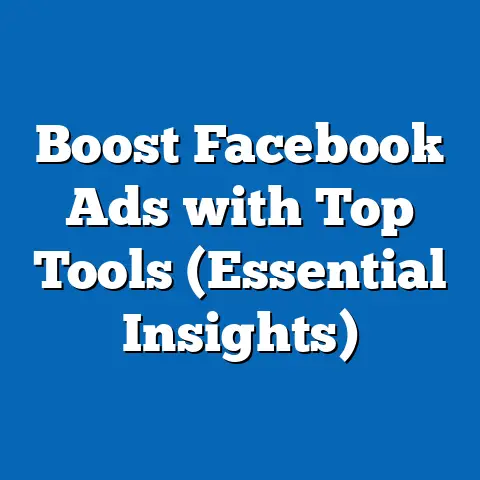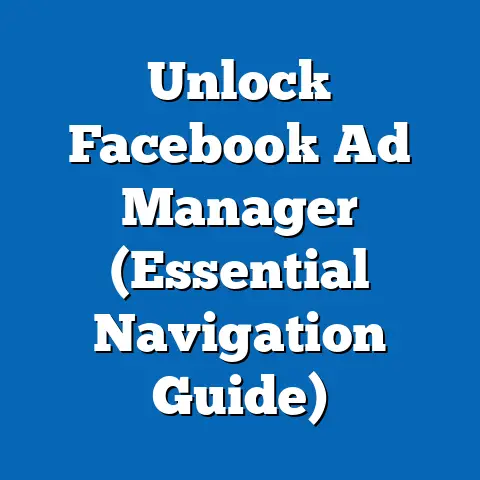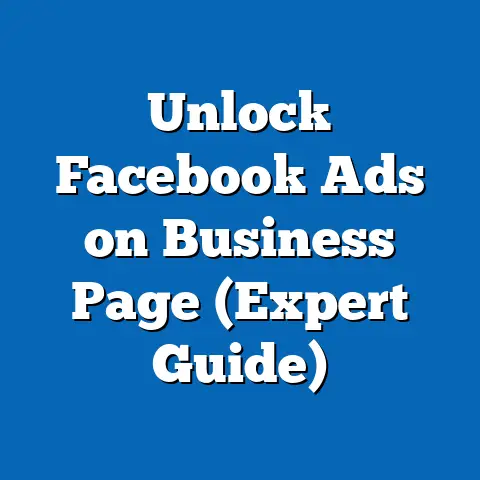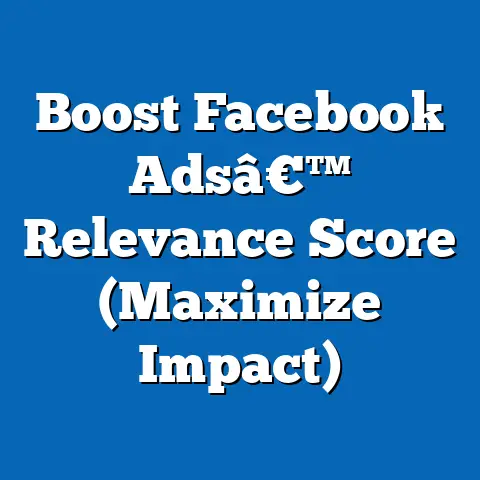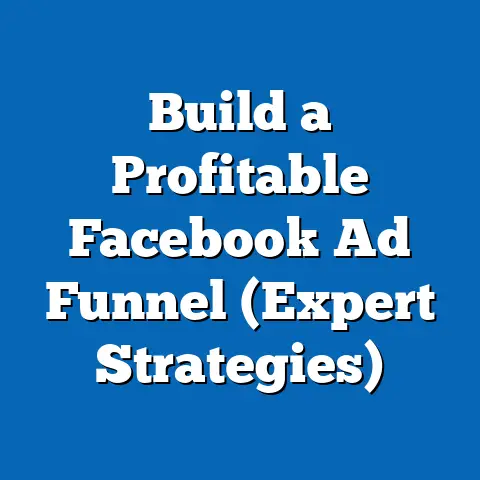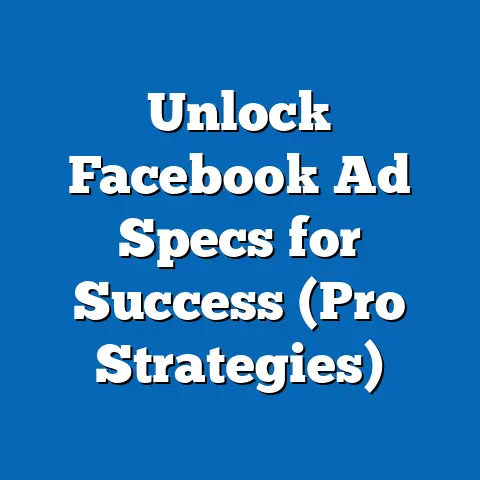Unlock Profitable fb ad Strategies (Innovative Alternatives)
It’s that time of year again! As autumn leaves begin to fall and the air turns crisp, a new season of opportunities arises for businesses. Just as the back-to-school buzz fills the air, savvy marketers are gearing up to capture the attention of eager consumers. The changing consumer behaviors during this season create unique opportunities for Facebook advertising, if you know how to seize them.
Facebook ads have become an indispensable tool in the digital marketing arsenal. With billions of users, Facebook provides an unparalleled platform to reach potential customers, build brand awareness, and drive sales. However, with great power comes great competition. Many businesses find themselves struggling to stand out in the crowded Facebook marketplace, relying on conventional strategies that yield diminishing returns.
That’s why I’m here to guide you through the exciting world of innovative and profitable alternatives to traditional Facebook ad strategies. This isn’t just about tweaking your existing campaigns; it’s about reimagining your approach and unlocking new levels of success. I’ll delve into advanced targeting techniques, explore creative ad formats, share compelling copy secrets, and reveal the power of user-generated content. By the end of this guide, you’ll be equipped with the knowledge and tools to transform your Facebook advertising game and achieve remarkable results.
Understanding the Facebook Advertising Landscape
Facebook’s advertising platform is a multifaceted beast, offering a diverse range of options to suit various business goals and budgets. From simple image ads to immersive video experiences, the possibilities seem endless. Let’s take a closer look at the landscape:
- Image Ads: The classic choice, these ads feature a single image and accompanying text. They’re simple to create and effective for showcasing products or services.
- Video Ads: Engaging and attention-grabbing, video ads are perfect for telling your brand story and demonstrating product features.
- Carousel Ads: Display multiple images or videos in a single ad unit, allowing you to showcase a range of products or highlight different aspects of your business.
- Slideshow Ads: Similar to video ads, but created from a sequence of images. They’re a great alternative for businesses with limited video resources.
- Collection Ads: Designed for e-commerce businesses, collection ads allow users to browse and purchase products directly from the ad.
- Instant Experience Ads: These immersive, full-screen ads load instantly and provide a seamless mobile experience.
- Lead Ads: Capture leads directly from Facebook without sending users to an external landing page.
The evolution of Facebook ads has been remarkable. Initially, simple text-based ads were the norm, but as the platform matured, so did its advertising capabilities. Today, Facebook ads are sophisticated and highly customizable, allowing businesses to target specific audiences with personalized messages.
I’ve seen firsthand the effectiveness of Facebook ads in various industries. For example, a local restaurant used carousel ads to showcase their seasonal menu, resulting in a 30% increase in reservations. An e-commerce store leveraged collection ads to drive sales of their back-to-school collection, achieving a 25% boost in revenue.
According to recent statistics, Facebook ads continue to be a dominant force in digital advertising. In 2023, Facebook’s ad revenue reached over \$116 billion, demonstrating the platform’s enduring popularity among advertisers. Moreover, studies show that Facebook ads have a higher conversion rate compared to other social media platforms.
However, with this popularity comes challenges. Many businesses struggle to achieve the desired results with conventional Facebook ad strategies. Common pitfalls include:
- Poor Targeting: Reaching the wrong audience with your ads.
- Uninspiring Ad Creative: Ads that fail to capture attention and engage users.
- Ineffective Ad Copy: Messages that don’t resonate with the target audience.
- Lack of Optimization: Failing to monitor and adjust campaigns based on performance data.
- Ignoring Platform Updates: Not keeping up with the constant changes of the Facebook Ads Manager.
These challenges can lead to wasted ad spend and missed opportunities. That’s why it’s crucial to explore innovative alternatives that can help you overcome these obstacles and achieve your advertising goals.
Takeaway: Facebook’s advertising landscape is vast and ever-evolving. Understanding the different ad formats and the challenges businesses face is essential for developing innovative and effective strategies.
The Importance of Audience Targeting
Audience targeting is the bedrock of successful Facebook advertising. It’s the process of identifying and reaching the specific group of people who are most likely to be interested in your products or services. Without effective targeting, your ads will be like a ship lost at sea, drifting aimlessly and failing to reach its destination.
Traditional demographic targeting (age, gender, location) is a good starting point, but it’s often not enough to achieve optimal results. To truly unlock the power of Facebook advertising, you need to delve deeper into innovative methods for audience segmentation:
- Psychographics: Understanding your audience’s values, interests, lifestyle, and personality traits. This allows you to create ads that resonate with their beliefs and aspirations. For example, if you’re selling eco-friendly products, you can target users who are passionate about sustainability and environmental conservation.
- Behavior-Based Targeting: Targeting users based on their online behavior, such as purchase history, website visits, and app usage. This allows you to reach people who have demonstrated an interest in your industry or products. For instance, you can target users who have recently visited your competitor’s website or added items to their online shopping cart.
- Interest-Based Targeting: Facebook allows you to target users based on their declared interests and hobbies. This can be a powerful way to reach niche audiences. If you’re selling fitness equipment, you can target users who are interested in running, yoga, or weightlifting.
Custom Audiences and Lookalike Audiences are two powerful tools that can significantly enhance your targeting capabilities.
- Custom Audiences: Create custom audiences by uploading your existing customer data (email addresses, phone numbers, website visitors, app users). This allows you to target your existing customers with personalized ads, cross-sell products, or encourage repeat purchases. I once helped a client in the real estate industry create a custom audience from their email list, and the result was a 40% increase in lead generation from their Facebook ads.
- Lookalike Audiences: Expand your reach by creating lookalike audiences based on your existing customer data. Facebook will identify users who share similar characteristics and behaviors with your best customers, allowing you to reach new prospects who are likely to be interested in your products or services. I’ve seen lookalike audiences consistently outperform standard demographic targeting, leading to higher conversion rates and lower cost per acquisition.
Micro-targeting takes audience segmentation to the next level. It involves focusing on very specific segments of your target audience with highly personalized ads. This approach can be incredibly effective, but it requires a deep understanding of your customers and their needs.
For instance, a clothing retailer could micro-target users who have purchased a specific item from their online store with ads for complementary products. A travel agency could micro-target users who have shown interest in a particular destination with ads for customized travel packages.
The key to successful micro-targeting is to create ads that are highly relevant and personalized to the specific audience segment. This requires careful planning and attention to detail, but the results can be well worth the effort.
Takeaway: Audience targeting is a critical component of Facebook advertising success. By going beyond standard demographics and exploring innovative segmentation methods, you can reach the right people with the right message and achieve remarkable results.
Creative Ad Formats and Content Ideas
Facebook offers a diverse range of ad formats, each with its own unique strengths and capabilities. To truly stand out in the crowded Facebook marketplace, you need to embrace innovative ad formats and content ideas that capture attention and engage your target audience.
Video ads have become increasingly important in the digital advertising landscape. They’re engaging, attention-grabbing, and perfect for telling your brand story. According to recent statistics, video ads generate more engagement and higher click-through rates compared to other ad formats.
Here are some tips for creating compelling video content:
- Keep it Short and Sweet: Attention spans are short, so aim for videos that are 15-30 seconds long.
- Grab Attention Quickly: Start with a visually appealing hook to capture viewers’ attention within the first few seconds.
- Tell a Story: Use storytelling techniques to connect with your audience on an emotional level.
- Showcase Your Product or Service: Highlight the key benefits and features of your product or service.
- Include a Clear Call to Action: Tell viewers what you want them to do next (e.g., visit your website, make a purchase, sign up for a newsletter).
Interactive content formats like polls, quizzes, and augmented reality (AR) ads can be incredibly effective for driving engagement and generating leads.
- Polls: Ask your audience a question and let them vote on their favorite option. This can be a great way to gather feedback and generate interest in your products or services.
- Quizzes: Create a fun and engaging quiz that tests your audience’s knowledge or helps them discover their personality type. This can be a great way to generate leads and drive traffic to your website.
- Augmented Reality (AR) Ads: Allow users to virtually try on products or experience your brand in a unique and immersive way. This can be particularly effective for fashion, beauty, and home decor brands.
Seasonal themes can be a powerful way to connect with your audience and create a sense of urgency. Consider creating holiday gift guides, summer travel tips, or back-to-school promotions. These types of ads can resonate with your audience and drive sales during specific times of the year.
I’ve seen brands successfully use these ad formats with seasonal themes to achieve remarkable results. For example, a fashion retailer created a holiday gift guide using carousel ads, showcasing different outfits for various occasions. This resulted in a 40% increase in online sales during the holiday season. A travel agency created a summer travel tips video ad, featuring stunning visuals and expert advice. This generated a surge in website traffic and a 30% increase in bookings.
Takeaway: Creative ad formats and content ideas are essential for capturing attention and engaging your target audience. By embracing video ads, interactive content, and seasonal themes, you can create memorable and effective campaigns that drive results.
Crafting Compelling Ad Copy
Your ad copy is the voice of your brand, the words that have the power to captivate, persuade, and ultimately, convert. It’s not just about writing grammatically correct sentences; it’s about crafting a message that resonates with your target audience and motivates them to take action.
To write persuasive ad copy that resonates with audiences, consider the following techniques:
- Know Your Audience: Understand their needs, desires, and pain points.
- Highlight Benefits, Not Just Features: Focus on how your product or service will improve their lives.
- Use Strong Verbs and Action Words: Create a sense of urgency and excitement.
- Keep it Concise and Clear: Get straight to the point and avoid jargon.
- Include a Clear Call to Action: Tell them what you want them to do next.
Storytelling can be a powerful tool for connecting with your audience on an emotional level. By sharing personal anecdotes, customer testimonials, or compelling narratives, you can create a deeper connection with your audience and build trust in your brand.
Emotional connections can lead to higher conversion rates. When people feel emotionally connected to your brand, they’re more likely to remember your message and make a purchase.
Here are some seasonal ad copy examples that tap into current events or holidays to create urgency:
- Back-to-School Sale: “Gear up for the new school year with our amazing back-to-school deals! Get 20% off all backpacks and school supplies for a limited time only.”
- Holiday Gift Guide: “Struggling to find the perfect gift? Our holiday gift guide has something for everyone on your list! Shop now and make this holiday season unforgettable.”
- Summer Travel Tips: “Escape the heat with our expert summer travel tips! Discover hidden gems and create unforgettable memories.”
A/B testing is a valuable method for refining your ad copy. It involves creating two or more versions of your ad copy and testing them against each other to see which performs better.
To analyze the results of your A/B tests, pay attention to the following metrics:
- Click-Through Rate (CTR): The percentage of people who click on your ad.
- Conversion Rate: The percentage of people who take the desired action after clicking on your ad (e.g., make a purchase, sign up for a newsletter).
- Cost Per Acquisition (CPA): The cost of acquiring a new customer.
By analyzing these metrics, you can identify the winning ad copy and use it to improve the performance of your future campaigns.
Takeaway: Compelling ad copy is essential for capturing attention and motivating your audience to take action. By understanding your audience, crafting persuasive messages, and leveraging storytelling techniques, you can create ads that resonate with your target audience and drive results.
Leveraging User-Generated Content
User-generated content (UGC) is any form of content (text, images, videos, reviews) created by your customers or fans. It’s a powerful tool for building trust, increasing brand awareness, and driving sales.
UGC is effective in advertising because it’s authentic, relatable, and trustworthy. People are more likely to trust recommendations from other customers than they are from brands themselves.
Here are some strategies for encouraging customers to create content that features your brand:
- Run Contests and Giveaways: Encourage customers to submit photos, videos, or stories featuring your brand for a chance to win a prize.
- Create a Branded Hashtag: Encourage customers to use your branded hashtag when sharing content related to your brand.
- Ask for Reviews and Testimonials: Encourage customers to leave reviews and testimonials on your website or social media pages.
- Feature Customer Content on Your Website and Social Media: Showcase the best UGC on your website and social media pages to inspire others to create content.
To integrate UGC into your Facebook ad campaigns, consider the following approaches:
- Use Customer Photos and Videos in Your Ads: Replace stock photos with authentic photos and videos created by your customers.
- Highlight Customer Reviews and Testimonials in Your Ads: Share positive reviews and testimonials to build trust and credibility.
- Create a UGC-Based Ad Campaign: Design an entire ad campaign around user-generated content.
I’ve seen real-world examples of successful UGC campaigns that have achieved remarkable results. For example, a clothing retailer ran a contest encouraging customers to share photos of themselves wearing their clothes. The winning photo was featured in their Facebook ad campaign, resulting in a 50% increase in sales.
Community engagement plays a vital role in building a loyal customer base through UGC. By fostering a strong sense of community, you can encourage customers to actively participate in your brand and create content that promotes your products or services.
Takeaway: User-generated content is a powerful tool for building trust, increasing brand awareness, and driving sales. By encouraging customers to create content that features your brand and integrating UGC into your Facebook ad campaigns, you can create authentic and engaging experiences that resonate with your target audience.
Optimizing Ad Performance through Analytics
Analytics are the compass that guides your Facebook advertising journey. They provide valuable insights into your campaign performance, allowing you to identify what’s working, what’s not, and where you can make improvements.
By tracking key performance indicators (KPIs), you can measure the success of your Facebook ad campaigns and make data-driven decisions for future campaigns.
Here are some essential KPIs to track:
- Reach: The number of unique people who saw your ad.
- Impressions: The number of times your ad was displayed.
- Click-Through Rate (CTR): The percentage of people who clicked on your ad.
- Conversion Rate: The percentage of people who took the desired action after clicking on your ad (e.g., make a purchase, sign up for a newsletter).
- Cost Per Acquisition (CPA): The cost of acquiring a new customer.
- Return on Ad Spend (ROAS): The amount of revenue generated for every dollar spent on advertising.
To interpret Facebook Insights data effectively, consider the following tips:
- Focus on the Most Important Metrics: Don’t get overwhelmed by the sheer volume of data. Focus on the KPIs that are most relevant to your business goals.
- Track Trends Over Time: Look for patterns and trends in your data to identify what’s working and what’s not.
- Segment Your Data: Analyze your data by different audience segments, ad placements, and ad formats to identify the most effective combinations.
- Use Data to Make Informed Decisions: Don’t rely on gut feelings. Use your data to make informed decisions about your targeting, ad creative, and bidding strategies.
Innovative tools and software can enhance ad performance analysis and reporting.
- Facebook Analytics: Facebook’s built-in analytics tool provides a wealth of data about your ad performance and audience demographics.
- Google Analytics: Integrate Google Analytics with your Facebook ad campaigns to track website traffic and conversions.
- Third-Party Analytics Tools: Explore third-party analytics tools that offer advanced reporting and analysis capabilities.
By leveraging these tools and insights, you can optimize your Facebook ad performance and achieve your advertising goals.
Takeaway: Analytics are essential for optimizing your Facebook ad performance. By tracking key performance indicators, interpreting Facebook Insights data, and leveraging innovative tools and software, you can make data-driven decisions that drive results.
Conclusion
In the dynamic world of Facebook advertising, innovation is the key to unlocking profitability. By embracing advanced targeting techniques, exploring creative ad formats, crafting compelling copy, leveraging user-generated content, and optimizing ad performance through analytics, you can transform your campaigns and achieve remarkable results.
I encourage you to experiment with the strategies outlined in this guide and discover what works best for your business. Remember, the potential for profitability in Facebook advertising is immense, but it requires a willingness to adapt, innovate, and continuously improve.
As autumn transitions into winter, and the holiday season approaches, remember that the strategies discussed in this guide can be immediately applied to upcoming events and promotions. Now is the time to take action and create Facebook ad campaigns that capture the spirit of the season and drive sales for your business.
Call to Action
I’d love to hear your own innovative Facebook ad strategies or success stories. Share your thoughts and experiences in the comments section below to foster community discussion and engagement. Let’s learn from each other and elevate our Facebook advertising game together!

